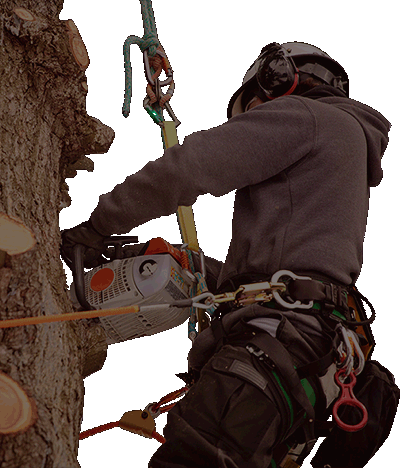
Creepy webs in trees, chewed up leaves or dying Spartanburg tree branches are surely not what you pictured in your charming fall landscape.
If you see something odd on your tree, find out what the problem is now.
Symptoms of the Most Common Fall Tree Insects

Symptoms: “Spider” webs on the ends of Spartanburg tree branches and leaf loss in late summer or early fall
• What insect is damaging my tree:Fall webworms, the Spartanburg tree nesters
• What do fall webworms do: They spin silky, solid webs on the ends of Spartanburg tree branches then feed on leaves from inside the netting.
• Most common Spartanburg tree victims of fall webworms: Wild cherry, black walnut, mulberry, sweetgum, pecan and persimmon
• How to control fall webworms: Physically remove the webs, and treat your Spartanburg tree with an insecticide.
• When to control fall webworms: Remove the webs as you spot them in fall, then follow up with an insecticide next spring.

Symptoms: Silky “webs” in trees, chewed leaves, mild to severe leaf loss and branch death with no regrowth on evergreens
• What insect is damaging my tree: The burrowed bagworm
• What do bagworms do: They weave protective bags of silk and debris to hide. Then, they consume Spartanburg tree leaves and needles.
• Most common Spartanburg tree victims of bagworms: Juniper, arborvitae, cedar, spruce, honeylocust, linden, willow, maple, oak, birch, elm and poplar
• How to control bagworms: Handpick and destroy all bags. Talk to your arborist about an insecticide treatment if there are too many to pick.
• When to treat bagworms: Remove and destroy bags as soon as you spot an infestation.
 Symptoms: Browning leaves with crunchy edges and itchy red spots on your skin
Symptoms: Browning leaves with crunchy edges and itchy red spots on your skin
• What insect is damaging my tree: A biting oak mite
• What do oak mites do: They feed on the larvae of other Spartanburg tree pests cooped up in your tree. Some oak mites may then fall off Spartanburg trees and use people as a host. Most commonly, these are found in Northeast Ohio and the Midwest.
• Most common Spartanburg tree victims of oak mites: All species of oak trees, particularly pin oak
• How to control oak mites: Wash your body after being under a suspecting oak Spartanburg tree since these mites don’t bite immediately. Then, talk to your local arborist about treatment.
• When to treat for oak mites: Be sure to clean off after some time under an oak Spartanburg tree to protect yourself.
 Symptoms: Needle loss on conifer trees, yellow-spotted Spartanburg tree needles, premature needle drop
Symptoms: Needle loss on conifer trees, yellow-spotted Spartanburg tree needles, premature needle drop
• What insect is damaging my tree: The sap-loving spruce spider mite
• What do spruce spider mites do: They feed on sap from Spartanburg tree needles and leave behind small, silk webs.
• Most common Spartanburg tree victims of spruce spider mites: Arborvitae, fir, hemlock, juniper and spruce
• How to control spruce spider mites: Reduce the population of these pests with dormant oil.
• When to get rid of spider mites: Treat in fall to rid your Spartanburg tree of mites before winter.
 Symptoms: Twig and branch death, premature leaf and flower loss, a sticky substance on leaves and branches, and black, sooty mold
Symptoms: Twig and branch death, premature leaf and flower loss, a sticky substance on leaves and branches, and black, sooty mold
• What insect is damaging my tree: The massive magnolia scale
• What does magnolia scale do: These large scale insects suck plant sap and produce a sugary substance called honeydew.
• Most common Spartanburg tree victims of magnolia scale: As their name suggests, they only feed on magnolia trees.
• How to control magnolia scale: Your arborist can recommend an insecticide treatment to get rid of this soft scale insect.
• When to treat for magnolia scale: Apply treatment before the winter season rolls in.
Symptoms: Small yellow bumps under Spartanburg tree leaves, mild leaf loss, severe or complete leaf loss on small and young trees
• What insect is damaging my tree: The not-so-pretty pink-striped oakworm moths
• What do oakworm moths do: The moths love to feed on any and all oak leaves.
• Most common Spartanburg tree victims of oakworm moths: Any oak species, maple, birch and hazel
• How to treat oakworm moths: The yellow bumps found under Spartanburg tree leaves are the moth’s eggs. Pick (or prune) those off. If damage has already occurred, your Spartanburg tree will need an insecticide treatment.
• When to control oakworm moths: Treat in early fall.







